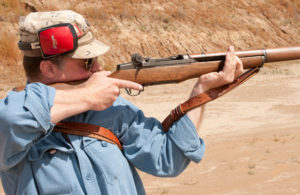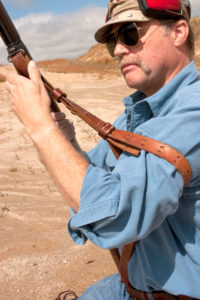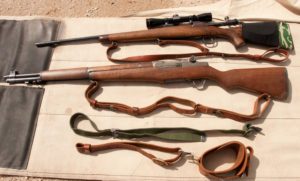By Peter Lessler, Gun Digest
One of the most useful rifle shooting aids is also one of the most neglected. That is the use of the loop sling. The support and steadiness it provides, when properly used, is enormous.

The hasty sling in offhand. Note rear strap across chest.
Contrary to what you may have read before, the sling does not “tie the rifle to your shoulder,” or to your arm for that matter.
What it does is to replace your support arm bicep muscle in holding up the weight of the rifle, not only taking one more trembling muscle out of the picture, but also preventing the support arm elbow joint angle from opening up and lowering the rifle, and even helping support the weight of the upper body in certain positions.
While proper use of the shooting loop sling was long a staple of military training and was well known amongst hunters, the military started getting away from teaching it in the years after the Korean War.
As a result, the knowledge of how to use this handy technique has all but disappeared from both the military and civilian worlds of riflery.
This is a shame, as a properly set-up sling is a major aid to gaining a steady position. Col. Cooper’s observations, if I recall correctly, were that the shooting loop sling is useful in perhaps 60% of rifle hunting situations, and increases your steadiness by about 30%. I personally think he was being conservative.
The best use of the shooting loop sling requires the support arm elbow (left elbow if you shoot righty) to be rested on a support. This can be a log, car hood (if legal for hunting in your state – it’s not in mine!), the ground (in prone), or your own leg (kneeling, squatting, or sitting).

Sliding the loop all the way up your support upper arm can be done quickly with practice so when you get into position your rifle is steadied.
When your elbow is hanging in the air you still have to use your support-side shoulder (front deltoid) muscle to hold everything up, so much of the steadiness a loop sling affords is wasted, since the only muscle it replaces is the bicep. If your elbow is not supported you can’t truly relax your support arm from shoulder to fingertips.
If the situation calls for – and allows – the taking of any position or rest where the support arm elbow is planted on something solid, the shooting sling is the quickest, simplest, and least cumbersome steadiness aid there is.
Got a bipod? Fine. How much weight does it add to your rifle, and how long does it take to deploy it and adjust its length properly?
Carrying shooting sticks? Okay, how do you like carrying them all day? How much movement do you make setting them up properly?
Granted, if your hunting style is to sit down, set up, and not move all day, the aforementioned shooting aids will work quite well. But if handiness and speed of deployment count, it’s hard to beat the right kind of shooting sling. With the modern fast-acquisition loop sling you can loop up in it while moving into position.
A proper shooting loop sling (as distinct from just a carry strap), used in the right situation, supports the weight of the rifle and allows you to relax into your position, thus freeing your muscles of the strain of holding up the rifle and recovering it on target after every shot. The rested elbow relieves your shoulder muscles of the task of holding up both arm and rifle.
Once your shoulder is no longer doing the work, the task of holding up the rifle is left to your support arm bicep, which has to keep tense to keep the weight of the rifle from sagging downwards. Now, wouldn’t it be nice to be able to substitute yet another stable support for a muscle that can tire and tremble?

4 loop sling types. From top: Ching, M1907, GI web, 2-piece target sling & cuff.
The shooting sling performs this task very nicely by forming a loop, which wraps around the back of your upper support arm (the higher the better) and the front of your wrist.
This loop captures and surrounds your entire arm, from the armpit to wrist, preventing the elbow joint from moving in a more open direction. Viewed from the side, you have a point-downwards rigid triangle formed by the sling horizontal across the top, and your forearm and upper arm forming the other two sides.
Gravity, attempting to pull the rifle downwards, has a tendency to work against your bicep muscle, making your support arm want to open up its angle through movement of the elbow joint (if your support elbow is positioned directly under the rifle).
But the sling, by wrapping around both your support wrist and support upper arm, will start to tighten up if this happens.
Forward and downward motion of that wrist against the sling pulls the sling against the back of your upper arm, and once it tightens up it will prevent your support wrist from moving any further downward (where the weight of the rifle wants to push it). Your bones and the sling do all the work.
This article is excerpted from the Gun Digest Shooter’s Guide to Rifle Marksmanship. Snag your copy for detailed instructions on how to properly use the rifle sling in all shooting positions.













